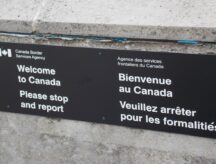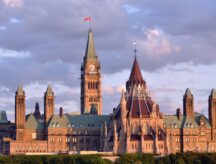Looming U.S. crackdown could strip right to work from thousands of foreign worker spouses
Thousands of mainly Indian spouses accompanying skilled foreign workers on H-1B visas in the United States are preparing for the possibility that they may lose their ability to work in June.
That's when the U.S. Department of Homeland Security (DHS) could rescind a rule introduced under former U.S. President Barack Obama in 2015 that gave spouses of certain H-1B visa holders the right to work under an H-4 visa.
Prior to the change, the spouses of H-1B holders could not work in the United States, leaving the H-1B visa holders they were accompanying as the sole breadwinners for their families.
The introduction of the H-4 Employment Authorization Document (EAD) changed this rule for spouses of H-1B holders who had applied for permanent residency and were waiting for a decision.
The H-4 EAD was heralded as welcome relief for both the families concerned and the spouses it allowed to work, many of whom are themselves highly skilled and had skilled work experience.
Since then, more than 100,000 H-4 holders have taken advantage of the EAD to get back to work.
Their newfound independence, however, could prove to be short-lived thanks to policies introduced by U.S. President Donald Trump, who came to power on a platform that promised to tighten immigration rules and protect American workers and industry from foreign competition.
The DHS has said its move to rescind the right to work under an H-4 visa is part of a wider effort to bring policies and practices in line with President Trump's "Buy America, Hire American" Executive Order.
Find out if you are eligible for Canadian Immigration by filling out our FREE online assessment form
Canada hoping to capitalize on U.S. policies
The move to rescind the H-4 EDA has added to the sense of uncertainty among foreign skilled workers in the United States resulting from policies introduced by the administration of U.S. President Donald Trump.
This atmosphere is widely believed to be fueling a spike in foreign skilled workers, and notably skilled workers in the Information Technology sector, who are setting their sights on Canadian immigration.
The skilled foreign labour that would be affected by President Trump's policies is highly prized by Canada’s federal and provincial governments, which have tailored their immigration policies and programs in recent years to facilitate the entry of such workers and their spouses into Canada.
Canada’s Global Skills Strategy and its Global Talent Stream component is one such example. Introduced in June, the Global Talent Stream has reduced processing times for temporary work permit applications for certain skilled workers to two weeks.
Spouses accompanying skilled foreign workers with a temporary work permit for Canada are entitled to an open work permit that that is not job-specific. The worker's dependents would also have the right to study in Canada. This applies to workers coming through the International Mobility Program and the Temporary Foreign Worker Program.
A recent report by Toronto tech sector hub MaRS says the Global Talent Stream is behind a sharp increase in international hires by tech companies based in the city, which is Canada's most populous and a popular destination for immigrants. The report also says tech companies in the city are reporting a major spike in applications from workers in the United States and cited the political climate there as a key reason for workers wanting to leave.
Canadian permanent residence
H-1B visa holders and their spouses who are looking to Canada also have numerous options for gaining Canadian permanent residence status, which is renewable after five years and allows holders to live and work anywhere in the country.
Express Entry is the federal government’s economic immigration system, which candidates can enter through one of three classes — the Federal Skilled Worker Class, the Federal Skilled Trades Class and the Canadian Experience Class.
H-1B applicants in the U.S. who have advanced proficiency in English, advanced education and skilled work experience would have a distinct advantage through Express Entry, which ranks candidates according to scores awarded for their so-called human capital factors, such as language proficiency, age, education and work experience. Applicants can also be awarded points for their spouse's credentials.
Indian nationals have enjoyed the most success through Canada’s immigration system, topping the list of nationals invited to apply through both the Express Entry system and the Provincial Nominee Program run by Ontario.
Provincial nomination
Provincial Nominee Programs (PNPs) are a popular fast-track option for gaining permanent residence. These programs allow Canada’s provinces and territories to nominate foreign workers for Canadian permanent residence based on local labour needs.
Many provinces also have enhanced PNP streams that are aligned with the Express Entry system and award Express Entry candidates with a provincial nomination an additional 600 points toward their CRS score.
Work permits
Entering Canada on a temporary work permit is another option, one that more than 300,000 foreign workers make use of each year. Canada offers a number of work permit options for temporary foreign workers through the International Mobility Program and the Temporary Foreign Worker Program.
To submit an inquiry about getting a work permit, please complete the form on this page.
Find out if you are eligible for Canadian Immigration by filling out our FREE online assessment form
© 2018 CICNews All Rights Reserved
- Do you need Canadian immigration assistance? Contact the Contact Cohen Immigration Law firm by completing our form
- Send us your feedback or your non-legal assistance questions by emailing us at media@canadavisa.com







